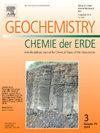铌钽锡氧化物作为岩浆分馏和岩浆热液演化的标志——以埃及东部沙漠Nuweibi花岗岩侵入岩为例
IF 2.9
3区 地球科学
Q2 GEOCHEMISTRY & GEOPHYSICS
引用次数: 0
摘要
努韦比稀有金属花岗岩位于埃及沙漠中东部,是侵入阿拉伯-努比亚盾新元古代基底岩的高度演化的浅花岗岩体。北北-南西向的斜左旋Dabr断裂将其分隔为两个主要的花岗岩相:西部块体的中粒钠长花岗岩和东部块体的斑状钠长花岗岩。浸染型铌钽锡矿化的主要矿石矿物为柱状矿群矿物(CGM)、木柳矿、微岩和锡石,具有明显的部分溶蚀和晚期再结晶的结晶顺序。这些矿石矿物通常有很强的分带性,表现出广泛的化学成分。在侵入体东部地块块状石英盖层中,奇特地发现了cm大小的自面体柱状晶体,具有薄的富ta边缘。基于矿物结构和微量矿物化学分析,本文提出了Nuweibi花岗岩体演化的成因模式,包括岩浆、岩浆-热液和亚固体成矿过程:1)花岗岩体熔体向上迁移至侵位水平,分异结晶导致残余熔体中不相容元素(如Ta、Nb、Sn)和挥发物(H2O和F)富集;2)早期富铌的CGM-1、钠长石和雪球石英的早期岩浆结晶与熔体中富集的Ta(比Nb更不相容);(3)岩浆-热液过渡阶段熔体流体饱和度开始,ggm -2岩浆结晶,Ta值越来越高,流体共存;4)岩浆热液条件下柱状体沉淀导致石英帽过冷饱和凝固;5)晚期岩浆流体循环,CGM溶蚀,CGM-3再沉淀,其次是晚期的木质岩和微岩;(6) Nuweibi花岗岩凝固后的斜左、正断裂,导致岩体西块体对角向上移动,形成了今天相反的暴露水平。结果表明,铌钽锡矿物的共生、结构和矿物化学特征是稀有金属花岗岩从岩浆到热液演化的重要示踪剂。本文章由计算机程序翻译,如有差异,请以英文原文为准。
Nb-Ta-Sn oxides as markers of magmatic fractionation and magmatic-hydrothermal evolution: The example of the Nuweibi granite intrusion, Eastern Desert, Egypt
The Nuweibi rare-metal granite is located in the Central Eastern Desert of Egypt and represents a highly evolved leucogranite pluton that intruded into Neoproterozoic basement rocks of the Arabian-Nubian Shield. It is separated by the NNE-SSW trending oblique sinistral Dabr fault into two principal granite facies: a medium-grained albite granite in the western block and a porphyritic albite granite in the eastern block. The major ore minerals among the disseminated Nb-Ta-Sn mineralization are columbite-group minerals (CGM), wodginite, microlite, and cassiterite, which follow a distinct crystallization sequence including partial dissolution and late recrystallization. These ore minerals are usually strongly zoned, exhibiting a wide range of chemical compositions. As peculiarity, cm-sized euhedral columbite crystals with thin Ta-rich rims are found in the massive quartz cap of the eastern block of the intrusion. On the basis of mineral textures and microanalysis of mineral chemistry of the Nb-Ta-Sn oxides, we propose a genetic model for the evolution of the Nuweibi granitic intrusion involving magmatic, magmatic-hydrothermal, and subsolidus ore-forming processes: 1) upward migration of a granitic melt to the level of emplacement and fractional crystallization resulting in enrichment of the residual melt in incompatible elements (e.g., Ta, Nb, Sn) and volatiles (H2O and F); 2) incipient magmatic crystallization of early Nb-rich CGM-1, albite, and snowball quartz and Ta enrichment in the melt (more incompatible than Nb); 3) onset of fluid exsolution (fluid saturation in the melt at the magmatic-hydrothermal transition), magmatic crystallization of CGM-2 with increasingly higher #Ta with co-existing fluid; 4) solidification of the quartz cap due to undercooling saturation with precipitation of columbite under hydrothermal conditions from magmatic fluids; 5) late magmatic fluid circulation, dissolution of the CGM and re-precipitation of CGM-3, followed by late-stage wodginite and microlite; 6) oblique sinistral and normal faulting after solidification of the Nuweibi granite, leading to the western block of the intrusion to move diagonally upwards resulting in today's opposing levels of exposure. As a result, the mineral paragenesis, texture, and mineral chemistry of Nb-Ta-Sn minerals prove to be remarkable tracers of the evolution from magmatic to hydrothermal conditions in rare-metal granites.
求助全文
通过发布文献求助,成功后即可免费获取论文全文。
去求助
来源期刊

Chemie Der Erde-Geochemistry
地学-地球化学与地球物理
CiteScore
7.10
自引率
0.00%
发文量
40
审稿时长
3.0 months
期刊介绍:
GEOCHEMISTRY was founded as Chemie der Erde 1914 in Jena, and, hence, is one of the oldest journals for geochemistry-related topics.
GEOCHEMISTRY (formerly Chemie der Erde / Geochemistry) publishes original research papers, short communications, reviews of selected topics, and high-class invited review articles addressed at broad geosciences audience. Publications dealing with interdisciplinary questions are particularly welcome. Young scientists are especially encouraged to submit their work. Contributions will be published exclusively in English. The journal, through very personalized consultation and its worldwide distribution, offers entry into the world of international scientific communication, and promotes interdisciplinary discussion on chemical problems in a broad spectrum of geosciences.
The following topics are covered by the expertise of the members of the editorial board (see below):
-cosmochemistry, meteoritics-
igneous, metamorphic, and sedimentary petrology-
volcanology-
low & high temperature geochemistry-
experimental - theoretical - field related studies-
mineralogy - crystallography-
environmental geosciences-
archaeometry
 求助内容:
求助内容: 应助结果提醒方式:
应助结果提醒方式:


